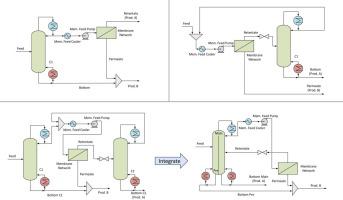Chemical Engineering Research and Design ( IF 3.7 ) Pub Date : 2023-04-23 , DOI: 10.1016/j.cherd.2023.04.041 Dian Ning Chia , Fanyi Duanmu , Eva Sorensen

|
The separation of azeotropic mixtures is often energy intensive, thus process intensification (PI) becomes an attractive route to enhance energy efficiency. Two of the most commonly used separation intensifications are dividing wall columns and hybrid distillation-membrane processes. In this work, three typical hybrid distillation structures, distillation followed by pervaporation (D-P), pervaporation followed by distillation (P-D), and distillation followed by pervaporation then by distillation (D-P-D), are considered and compared with a hybrid dividing wall column (H-DWC) structure, which is a highly integrated process combining a dividing wall column and a pervaporation membrane network. The four structures are compared by both single-objective and multi-objective optimisation. It is shown that the D-P-D and H-DWC structures require significantly lower total annualized costs than the other two designs due to requiring smaller membrane area, as these two structures use the membrane only to help the mixture composition cross the azeotropic point.
中文翻译:

混合蒸馏-渗透蒸发和分隔壁塔结构的单目标和多目标优化
共沸混合物的分离通常是能源密集型的,因此过程强化 (PI) 成为提高能源效率的有吸引力的途径。两种最常用的分离强化是分隔壁塔和混合蒸馏-膜工艺。在这项工作中,考虑了三种典型的混合蒸馏结构,蒸馏后渗透蒸发 (DP)、渗透蒸发后蒸馏 (PD) 和蒸馏后渗透蒸发后蒸馏 (DPD),并与混合分隔壁塔 (H -DWC)结构,这是一个高度集成的过程,结合了分隔壁塔和渗透汽化膜网络。通过单目标和多目标优化来比较这四种结构。































 京公网安备 11010802027423号
京公网安备 11010802027423号